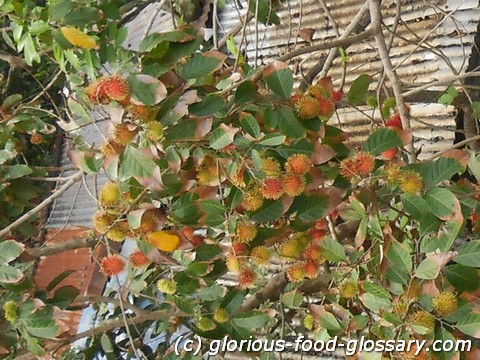Deutsch: Rambutan-Baum / Español: Árbol de Rambután / Português: Árvo de Rambutã / Français: Arbre de Ramboutan / Italiano: Albero di Rambutan
Puno ng Rambutan refers to the tree that bears the rambutan fruit, a popular tropical fruit native to Southeast Asia. The rambutan tree is part of the Sapindaceae family, which also includes other well-known fruits like lychee and longan. Rambutan fruits are known for their hairy appearance, with a soft, sweet, and juicy flesh inside that encases a single seed. The name "rambutan" comes from the Malay word "rambut," meaning hair, which describes the fruit's unique, hairy exterior.
Description
Rambutan trees thrive in tropical climates and are widely cultivated in countries such as Indonesia, Malaysia, the Philippines, and Thailand. The fruit is typically harvested twice a year, and its taste is often compared to that of the lychee but with its own distinct sweetness and slightly acidic flavor. The skin of the rambutan is red or yellow when ripe and peels away easily to reveal the translucent, juicy flesh inside.
Application Areas
In the culinary context, rambutan is mostly consumed fresh, eaten by peeling off the outer skin to enjoy the sweet flesh. However, it is also used in various dishes and desserts across Southeast Asia. It can be added to fruit salads, desserts, and even some savory dishes. Additionally, rambutan can be canned, made into jams, or used to flavor drinks and cocktails.
Well-Known Examples
While eating fresh rambutan remains the most common way to enjoy the fruit, innovative uses include rambutan cocktails, where the fruit's juice is mixed with spirits to create refreshing tropical drinks, and rambutan curry, a unique dish that incorporates the fruit into a savory curry sauce. In the Philippines, rambutan is often mixed with other tropical fruits in a dessert called fruit salad, made with condensed milk and cream.
Treatment and Risks
Rambutan is not only delicious but also nutritious, offering a good source of vitamin C, minerals, and other nutrients. However, the seed of the rambutan is inedible in its raw form due to potentially toxic compounds. It's important to consume only the flesh of the fruit and avoid the seed. There are no significant health risks associated with consuming rambutan flesh, but as with all fruits, it should be eaten in moderation as part of a balanced diet.
Recipes
Rambutan Fruit Salad Recipe:
Ingredients:
- 1 cup fresh rambutan, peeled and pitted
- 1 cup fresh mango, diced
- 1 cup fresh pineapple, diced
- 1/2 cup condensed milk
- 1/2 cup heavy cream
- Optional: other tropical fruits like papaya or lychee
Instructions:
- In a large mixing bowl, combine the peeled and pitted rambutan with the diced mango and pineapple. Add any other tropical fruits as desired.
- In a separate bowl, mix the condensed milk and heavy cream until well combined.
- Pour the milk and cream mixture over the fruits and gently mix until all the fruits are coated evenly.
- Refrigerate the fruit salad for at least an hour before serving to allow the flavors to meld together.
- Serve chilled as a refreshing dessert.
Similar Terms or Synonyms
In different parts of the world, rambutan may be known by various local names, but "rambutan" is the most widely recognized term internationally, derived from its characteristic hairy appearance.
Summary
Puno ng Rambutan produces the delightful rambutan fruit, cherished across Southeast Asia and increasingly popular worldwide for its exotic appearance and sweet, juicy flavor. Whether enjoyed fresh or incorporated into a variety of culinary creations, rambutan exemplifies the richness of tropical fruit biodiversity and offers a taste of Southeast Asian culture and hospitality.
--


